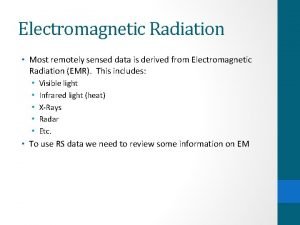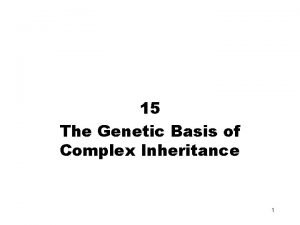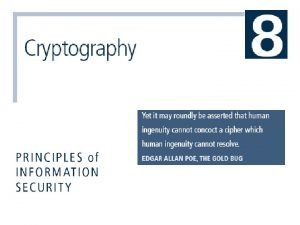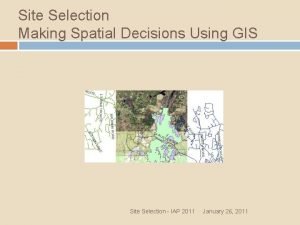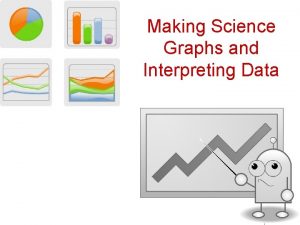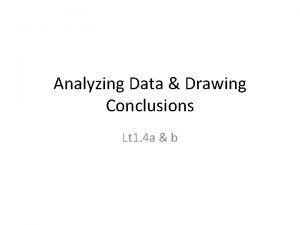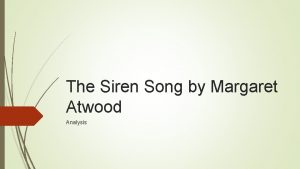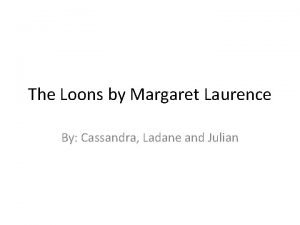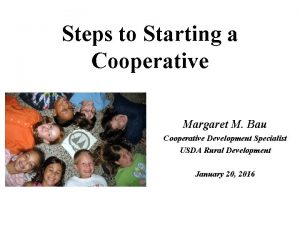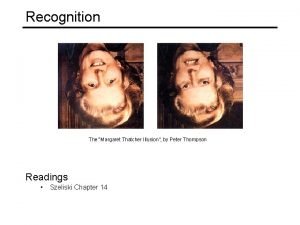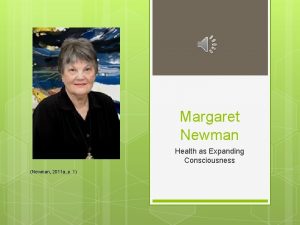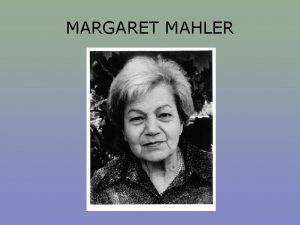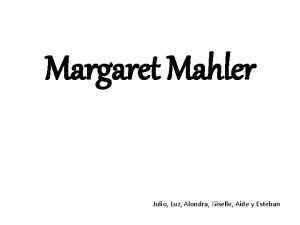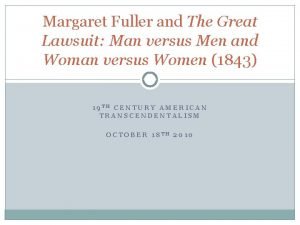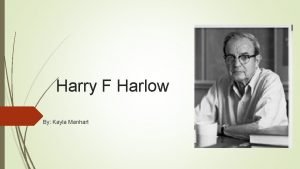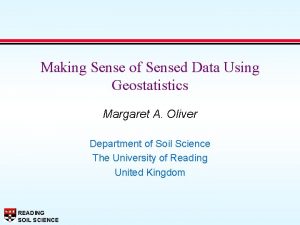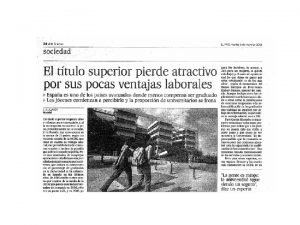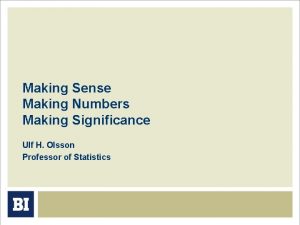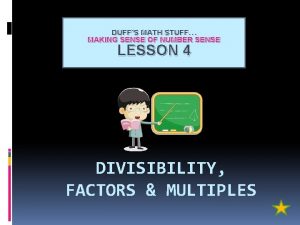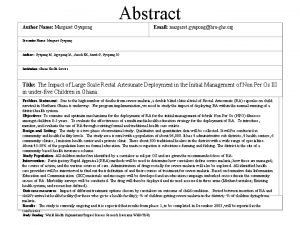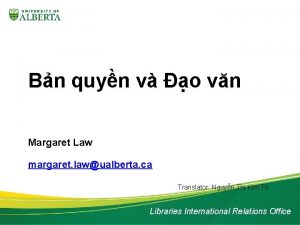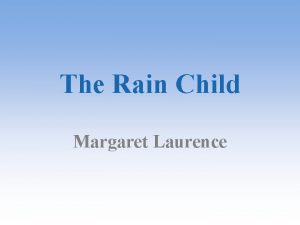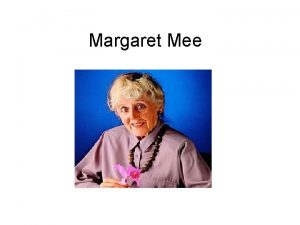Making Sense of Sensed Data Using Geostatistics Margaret










































- Slides: 42

Making Sense of Sensed Data Using Geostatistics Margaret A. Oliver Department of Soil Science The University of Reading United Kingdom READING SOIL SCIENCE

Acknowledgements I thank Ruth Kerry for the use of her data, and the USA Army for the use of their SPOT and DEM data. READING SOIL SCIENCE

Overview l l What do we mean by sensed data? Why geostatistics might be of use with such data? Nested variation and how it can be investigated. Case studies: » using three types of sensed data. » using satellite imagery » taking account of trend in data l Conclusions READING SOIL SCIENCE

Sensed data l l A major problem for farmers in the precision agriculture context is to obtain enough data about soil and crop properties to show the variation accurately for management Methods of sensing have the advantage of producing large amounts of spatially referenced data relatively cheaply and quickly Some sensors can be linked with GPS and farm equipment e. g. tractor mounted or on combines In many cases the process is non-destructive and noninvasive which avoids damage to the soil and crop roots. READING SOIL SCIENCE

Sensed data can measure soil and crop properties - such information is likely to change agricultural management in the context of site specific farming Examples: radiometers to detect weeds yield monitoring satellite imagery, hyperspectral data, aerial photographs, microwave radiation chlorophyll sensor - measures short wave radiation soil conductivity - by electromagenetic induction or direct contact READING SOIL SCIENCE

Sensed data - difficulties l l l Sensors generally produce large amounts of data that can be both difficult to process and interpret. Interference during recording There are differences in the resolution of different sources of sensed data. » what is a suitable resolution for precision agriculture, for example? » does more data necessarily mean better information? READING SOIL SCIENCE

Sensed data - difficulties (cont. ) l l l Too much detail and also noise from measurement errors can obscure the structures of interest in the variation. Often more than one scale of variation is present (nested variation). Can be difficult to relate sensor information to ground information, such as soil conditions and vegetation types. READING SOIL SCIENCE

How can geostatistics help? l l l Geostatistics provides tools to explore the variation of both sparse and large sets of data. The variogram can be used to detect the presence of nested variation. Nested variogram models can decompose the variation to the spatial scales of variation present. READING SOIL SCIENCE

How can geostatistics help? (cont. ) l l l Ordinary kriging can smooth the variation so that the main structures in the variation can be observed. Kriging analysis or factorial kriging can filter the components of variation of interest. An important aim is to understand the factors that are controlling the variation READING SOIL SCIENCE

The variogram l l l Describes how a property varies with distance and direction Computed by: Models can be fitted to the experimental semi-variances READING SOIL SCIENCE

Kriging: geostatistical estimation l l A local weighted moving average calculated for points or blocks Weights depend on the structure of spatial variation and configuration of sampling points The weights are derived from the variogram Kriging differs from other interpolators - it uses a model of the spatial variation READING SOIL SCIENCE

Nested Variation l Variation in many environmental properties arises from processes that operate and interact at different spatial scales » climate, geology, relief, hydrology, trees, earthworms, microbiota and so on l l Each factor might result in several scales of variation Structure at one scale is ‘noise’ at another READING SOIL SCIENCE

Nested Variation l l l A random process can be several independent processes nested within one another. They act at different spatial scales. The variogram of Z(x) is then a nested combination of two or more individual variograms. READING SOIL SCIENCE

Nested variogram: linear model of regionalization l l The nested variogram comprises more than one variogram structure. Each structure might represent a separate process. The individual variograms that comprise it are additive. They are uncorrelated with each other and are independent orthogonal functions. READING SOIL SCIENCE

Nested variogram: linear model of regionalization l Assume that the variogram of Z(x) is a nested combination of S individual variograms: l Assuming that the processes are uncorrelated, the linear model of regionalization for S basic variograms is: each process has its own variogram: bk g k(h) READING SOIL SCIENCE

Kriging Analysis or Factorial Kriging l l The aim is to separate out the components of variation of interest and to krige them Devised by Matheron (1982) to estimate the variogram components separately This is equivalent to filtering each component from the others If the variation is nested it can be explored further by factorial kriging READING SOIL SCIENCE

Kriging Analysis or Factorial Kriging (cont. ) l l Kriging analysis is based on the concept that Z(x) can be decomposed into two or more independent processes For a property with three spatial components including the nugget, the relation becomes Each component of the variation is treated as signal in turn. Noise at one scale of variation is regarded as information at another. READING SOIL SCIENCE

Case study: Yattendon Estate, Berkshire This study describes an analysis of three kinds of sensed data: l l l Yield data Digital information from aerial photographs EMI data READING SOIL SCIENCE

Aerial photograph image for Yattendon 1986 READING SOIL SCIENCE

Experimental variogram and model for green waveband 1986 a) Experimental variogram Lag distance/3. 4 m READING SOIL SCIENCE b) Fitted nested model Lag distance/3. 4 m c) Decomposed variogram Lag distance/3. 4 m

Aerial photograph image for Yattendon 1986 a) Raw data READING SOIL SCIENCE b) Ordinary kriged predictions

Aerial photograph image for Yattendon 1986 Results of factorial kriging: a) Long-range estimates READING SOIL SCIENCE b) Short-range estimates

The EMI data contained long-range trend. This was removed by a linear function. The remaining analyses were done on the residuals from this trend READING SOIL SCIENCE

Experimental variogram and model for residuals from the EMI data a) Experimental variogram READING SOIL SCIENCE b) Fitted nested model c) Decomposed variogram

Electromagnetic Induction (EMI) data for Yattendon 2000 a) Raw data READING SOIL SCIENCE b) Ordinary kriged predictions of the residuals

Factorial kriging of (EMI) data for Yattendon 2000 Results of factorial kriging: c) Long-range component READING SOIL SCIENCE d) Short-range component

Experimental variogram and model for yield 1997 a) Experimental variogram READING SOIL SCIENCE b) Fitted nested model c) Decomposed variogram

Yield for Yattendon a) Raw data READING SOIL SCIENCE b) Ordinary kriged predictions of the residuals

Factorial kriging of Yield for Yattendon Results of factorial kriging: c) Long-range component READING SOIL SCIENCE d) Short-range component

Preliminary results for some soil properties READING SOIL SCIENCE

Summary The three kinds of ancillary data show similar nested patterns of variation. Relations with volumetric water content, topsoil stoniness and loss on ignition are visibly strong. Suggests that variograms of ancillary data could be used to guide sampling of the soil. Other soil properties are being analysed at present. READING SOIL SCIENCE

Case Study: SPOT image of Fort A. P. Hill l l The part of the scene analysed is of Fort A. P. Hill in Virginia, USA 128 by 128 pixels - 16384 in total Analysed the near infrared range of the electromagnetic spectrum (NIR) Multiresolution analysis has relevance for further sampling and for selecting the level of variation to be retained with data compression. READING SOIL SCIENCE

Near infra red (NIR) for Fort A. P. Hill, USA. a) Raw data b) Variogram Lag distance/pixel (20 m) READING SOIL SCIENCE

Near infra red (NIR) for Fort A. P. Hill, USA. Results of factorial kriging: c) Long-range component b) Short-range component Factorial kriging filtered out effectively the two main scales of spatial variation READING SOIL SCIENCE

Ground cover survey of Fort A. P. Hill, USA. b) Multivariate variogram of ground cover classes The variograms of the wavebands and NDVI were used to design several surveys of ground cover. The multivariate variogram computed from seven classes of cover shows a similar form to the variogram of NIR. READING SOIL SCIENCE

NIR Tiled variograms for Fort A. P. Hill, USA READING SOIL SCIENCE

Case Study: DEM of Fort A. P. Hill This study examines data that contain trend which violates the assumptions of the random function model that underpins geostatistics. The data were on a 5 m grid - this was sub-sampled to a 20 m grid to match the SPOT pixel size. Linear, quadratic and cubic functions were fitted to the coordinates of the data. READING SOIL SCIENCE

Digital elevation data for Fort A. P. Hill, USA: variograms from 20 m grid. a)Variogram of the raw data Lag distance / 20 m c) Variogram of the quadratic residuals READING SOIL SCIENCE Lag distance / m b) Variogram of the linear residuals Lag distance / m d) Variogram of the cubic residuals Lag distance / m

Digital elevation data for Fort A. P. Hill, USA. a) Ordinary kriged estimates of the quadratic residuals READING SOIL SCIENCE

Digital elevation data for Fort A. P. Hill, USA. Quadratic residuals a) Long-range estimates READING SOIL SCIENCE b) Short-range estimates

Fort A. P. Hill: NIR and DEM Punctually kriged estimates of NIR READING SOIL SCIENCE Punctually kriged estimates of DEM

Conclusions l l The richness of data from sensors often obscures the information required for interpretation. Nevertheless such information could be the basis for managing many aspects of the environment in the future. Geostatistical and other methods, such as the rapidly developing wavelet analyses, provide tools for exploring sensed data in an analytical framework. The links with ground information are vital and require detailed fieldwork as a precursor to using these relatively cheap sources of information as a partial substitute. READING SOIL SCIENCE
 Remotely sensed data
Remotely sensed data Element of dance body
Element of dance body Narrow sense heritability vs broad sense heritability
Narrow sense heritability vs broad sense heritability Narrow sense heritability vs broad sense heritability
Narrow sense heritability vs broad sense heritability Making sense of discourse analysis
Making sense of discourse analysis What is inferring
What is inferring War making and state making as organized crime
War making and state making as organized crime Qlik sense data modeling best practices
Qlik sense data modeling best practices Mamdm
Mamdm Using functions in models and decision making
Using functions in models and decision making The process of making and using codes to secure information
The process of making and using codes to secure information Making spatial decisions using gis
Making spatial decisions using gis Decision making using excel
Decision making using excel Using system.collections
Using system.collections Defrost using internal heat is accomplished using
Defrost using internal heat is accomplished using Interpreting graphs science
Interpreting graphs science Greg linden
Greg linden Drawing conclusions from data
Drawing conclusions from data Stern utvecklingspsykologi
Stern utvecklingspsykologi Meaning of siren song
Meaning of siren song The moment margaret atwood
The moment margaret atwood The loons short story
The loons short story Margaret schlosser autopsy photos
Margaret schlosser autopsy photos City planners poem analysis
City planners poem analysis Margaret bau
Margaret bau Margaret thatcher illusion
Margaret thatcher illusion Rape fantasies margaret atwood
Rape fantasies margaret atwood Margaret searle
Margaret searle Margaret ikongo
Margaret ikongo Margaret vugrin
Margaret vugrin Supranational bonds cfa
Supranational bonds cfa Margaret mahler fazy rozwoju
Margaret mahler fazy rozwoju Margaret haddix
Margaret haddix Margaret newman biography
Margaret newman biography Margaret morrell supervision training
Margaret morrell supervision training Egoico
Egoico Fases de individuacion segun margaret mahler
Fases de individuacion segun margaret mahler Margaret fuller the great lawsuit
Margaret fuller the great lawsuit Margaret dechant
Margaret dechant Margaret atwood surfacing
Margaret atwood surfacing Margaret mahler
Margaret mahler Margaret panting
Margaret panting Abraham maslow, stephen suomi
Abraham maslow, stephen suomi
